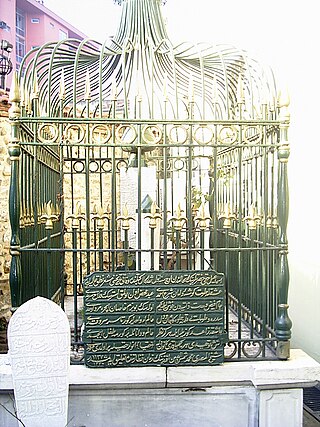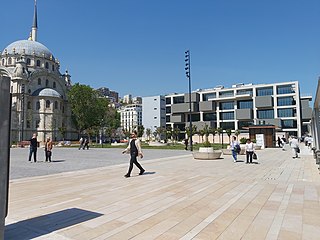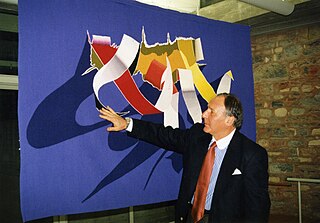Related Research Articles

Rock candy or sugar candy, also called rock sugar, or crystal sugar, is a type of confection composed of relatively large sugar crystals. This candy is formed by allowing a supersaturated solution of sugar and water to crystallize onto a surface suitable for crystal nucleation, such as a string, stick, or plain granulated sugar. Heating the water before adding the sugar allows more sugar to dissolve thus producing larger crystals. Crystals form after six to seven days. Food coloring may be added to the mixture to produce colored candy.

The Battle of Sarikamish was an engagement between the Russian and the Ottoman Empires during World War I that took place from December 22, 1914, to January 17, 1915, as part of the Caucasus campaign.

Fatih is a municipality and district of Istanbul Province, Turkey. Its area is 15 km2, and its population is 368,227 (2022). It is home to almost all of the provincial authorities but not the courthouse. It encompasses the peninsula coinciding with old Constantinople. In 2009, the district of Eminönü, which had been a separate municipality located at the tip of the peninsula, was once again remerged into Fatih because of its small population. Fatih is bordered by the Golden Horn to the north and the Sea of Marmara to the south, while the Western border is demarked by the Theodosian wall and the east by the Bosphorus Strait.

The 1913 Ottoman coup d'état, also known as the Raid on the Sublime Porte, was a coup d'état carried out in the Ottoman Empire by a number of Committee of Union and Progress (CUP) members led by Ismail Enver Bey and Mehmed Talaat Bey, in which the group made a surprise raid on the central Ottoman government buildings, the Sublime Porte. During the coup, the Minister of War, Nazım Pasha, was assassinated and the Grand Vizier, Kâmil Pasha, was forced to resign. After the coup, the government fell into the hands of the CUP, now under the leadership of the triumvirate known as the "Three Pashas", made up of Enver, Talaat, and Cemal Pasha.

Architecture of Turkey or Turkish architecture in the Republican Period is the architecture practised in Turkey since the foundation of the republic in 1923. In the first years of the republic, Turkish architecture was influenced by Seljuk and Ottoman architecture, in particular during the First National Architectural Movement. However, starting from the 1930s, architectural styles began to differ from traditional architecture, also as a result of an increasing number of foreign architects being invited to work in the country, mostly from Germany and Austria. The Second World War was a period of isolation, during which the Second National Architectural Movement emerged. Similar to Fascist architecture, the movement aimed to create a modern but nationalistic architecture.

Çerkes Ethem, known in English as Ethem the Circassian, was a Circassian Ottoman guerilla leader, social bandit, efe and soldier. He initially gained fame for establishing the Kuva-yi Seyyare and putting down multiple large-scale rebellions and gaining key major victories against the Greek armies invading Anatolia during the Turkish War of Independence.

The Karacaahmet Cemetery is a 700-year-old historic cemetery, located in Üsküdar, the Asian side of Istanbul. Karacaahmet cemetery is the oldest and largest in Istanbul at 750 acres (3.0 km2), and the largest burial ground in Turkey by the number of interred.
Safiye Ayla was one of the most famous singers of Turkish classical music.

Mehmet Hakkı Suçin is an author, literary translator and Arabist from Turkey.

The Aviation Martyrs' Monument, located in Fatih district of Istanbul, Turkey, is a memorial dedicated to the first soldiers of the Ottoman Airforce to be killed in flight accidents. In Turkey, one use of the term "martyr" is as an honorific for people killed in action during war.
The Ottoman Military College or Imperial Military Staff College or Ottoman Army War College, was a two-year military staff college of the Ottoman Empire. It was located in Constantinople. Its mission was to educate staff officers for the Ottoman Army.
Kazasker Mustafa Izzet Efendi, was an Ottoman composer, neyzen, poet and statesman best known for his calligraphy.

İsmail Hakkı Bursevî was a 17th-century Ottoman Turkish Muslim scholar, a Jelveti Sufi author on mystical experience and the esoteric interpretation of the Quran; also a poet and musical composer. İsmail Hakkı Bursevî influenced many parts the Ottoman Empire but primarily Turkey. To this day he is revered as one of the Büyükler, the great saints of Anatolia.

Burak Özçivit is a Turkish actor and model who is best known for his roles in Çalıkuşu (2013–2014) and Kara Sevda (2015–2017). He is currently starring as Osman Bey in the history-based, adventure series Kuruluş: Osman (2019–present). Throughout his acting career Özçivit has been a recipient of numerous accolades.
Hatice Aynışah Sultan was an Ottoman princess, daughter of Sultan Bayezid II and half-sister of Sultan Selim I of the Ottoman Empire.

The İstanbul Painting and Sculpture Museum is in the Tophane area of European İstanbul, Turkey, and is part of the large Galataport complex.
Hafız Selman İzbeli was a Turkish militia member in the Turkish War of Independence and the first female councilwoman in Kastamonu.

Yahşi Baraz is a Turkish art dealer. He is the founder and the director of one of Turkey's earliest art galleries, Galeri Baraz.
References
- ↑ "About us | Hafiz Mustafa 1864". en.hafizmustafa.com. Retrieved 2021-12-14.
- ↑ "Hafiz Mustafa: Istanbul confectionery now exporting". aa.com.tr. Retrieved 2021-12-14.
- ↑ "Sweets that saw the birth of modern Turkey". live2makan. Retrieved 2021-12-14.
- ↑ "Branches | Hafiz Mustafa 1864". en.hafizmustafa.com. Retrieved 2021-12-14.
- ↑ "Hafız Mustafa, Dubai'de mağaza açtı!". medyaege.com.tr. Retrieved 2021-12-14.